University of Hail Nursing Research Critique Report
VerifiedAdded on 2022/08/24
|12
|2578
|19
Report
AI Summary
This report presents a detailed critique of a nursing research paper that investigated the application of Janis and Mann's decisional conflict theory (DCT) in predicting exercise decisions following myocardial infarction (MI) among Jordanian patients. The critique evaluates the study's title, introduction, literature review, research questions, methodology (including sampling, data collection, and ethical considerations), data analysis, discussion, and conclusion. The paper highlights the strengths and weaknesses of the study, including the appropriateness of the research design, data analysis techniques, and the limitations of the study, such as the use of a cross-sectional design and a relatively small sample size. The critique also discusses the study's findings, such as the significant relationship between the benefits-barriers interaction and stress for non-exercisers, and the predictors of MI patients' decisions to exercise. Overall, the critique provides a comprehensive assessment of the research paper, offering insights into its contributions to the field and suggestions for future research.

Running head: CRITIQUE 1
Critique
Name
Institutional Affiliation
Critique
Name
Institutional Affiliation
Paraphrase This Document
Need a fresh take? Get an instant paraphrase of this document with our AI Paraphraser
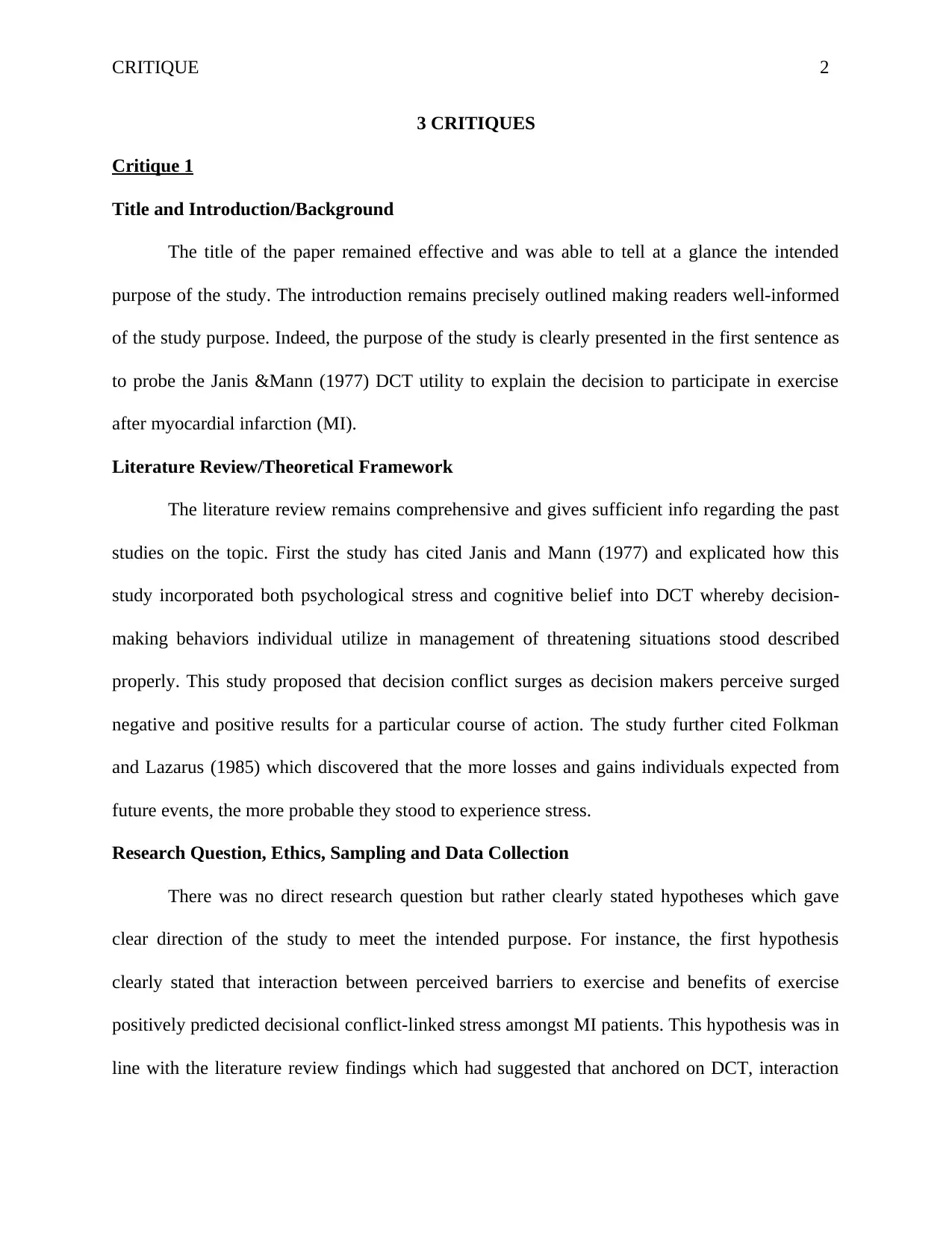
CRITIQUE 2
3 CRITIQUES
Critique 1
Title and Introduction/Background
The title of the paper remained effective and was able to tell at a glance the intended
purpose of the study. The introduction remains precisely outlined making readers well-informed
of the study purpose. Indeed, the purpose of the study is clearly presented in the first sentence as
to probe the Janis &Mann (1977) DCT utility to explain the decision to participate in exercise
after myocardial infarction (MI).
Literature Review/Theoretical Framework
The literature review remains comprehensive and gives sufficient info regarding the past
studies on the topic. First the study has cited Janis and Mann (1977) and explicated how this
study incorporated both psychological stress and cognitive belief into DCT whereby decision-
making behaviors individual utilize in management of threatening situations stood described
properly. This study proposed that decision conflict surges as decision makers perceive surged
negative and positive results for a particular course of action. The study further cited Folkman
and Lazarus (1985) which discovered that the more losses and gains individuals expected from
future events, the more probable they stood to experience stress.
Research Question, Ethics, Sampling and Data Collection
There was no direct research question but rather clearly stated hypotheses which gave
clear direction of the study to meet the intended purpose. For instance, the first hypothesis
clearly stated that interaction between perceived barriers to exercise and benefits of exercise
positively predicted decisional conflict-linked stress amongst MI patients. This hypothesis was in
line with the literature review findings which had suggested that anchored on DCT, interaction
3 CRITIQUES
Critique 1
Title and Introduction/Background
The title of the paper remained effective and was able to tell at a glance the intended
purpose of the study. The introduction remains precisely outlined making readers well-informed
of the study purpose. Indeed, the purpose of the study is clearly presented in the first sentence as
to probe the Janis &Mann (1977) DCT utility to explain the decision to participate in exercise
after myocardial infarction (MI).
Literature Review/Theoretical Framework
The literature review remains comprehensive and gives sufficient info regarding the past
studies on the topic. First the study has cited Janis and Mann (1977) and explicated how this
study incorporated both psychological stress and cognitive belief into DCT whereby decision-
making behaviors individual utilize in management of threatening situations stood described
properly. This study proposed that decision conflict surges as decision makers perceive surged
negative and positive results for a particular course of action. The study further cited Folkman
and Lazarus (1985) which discovered that the more losses and gains individuals expected from
future events, the more probable they stood to experience stress.
Research Question, Ethics, Sampling and Data Collection
There was no direct research question but rather clearly stated hypotheses which gave
clear direction of the study to meet the intended purpose. For instance, the first hypothesis
clearly stated that interaction between perceived barriers to exercise and benefits of exercise
positively predicted decisional conflict-linked stress amongst MI patients. This hypothesis was in
line with the literature review findings which had suggested that anchored on DCT, interaction
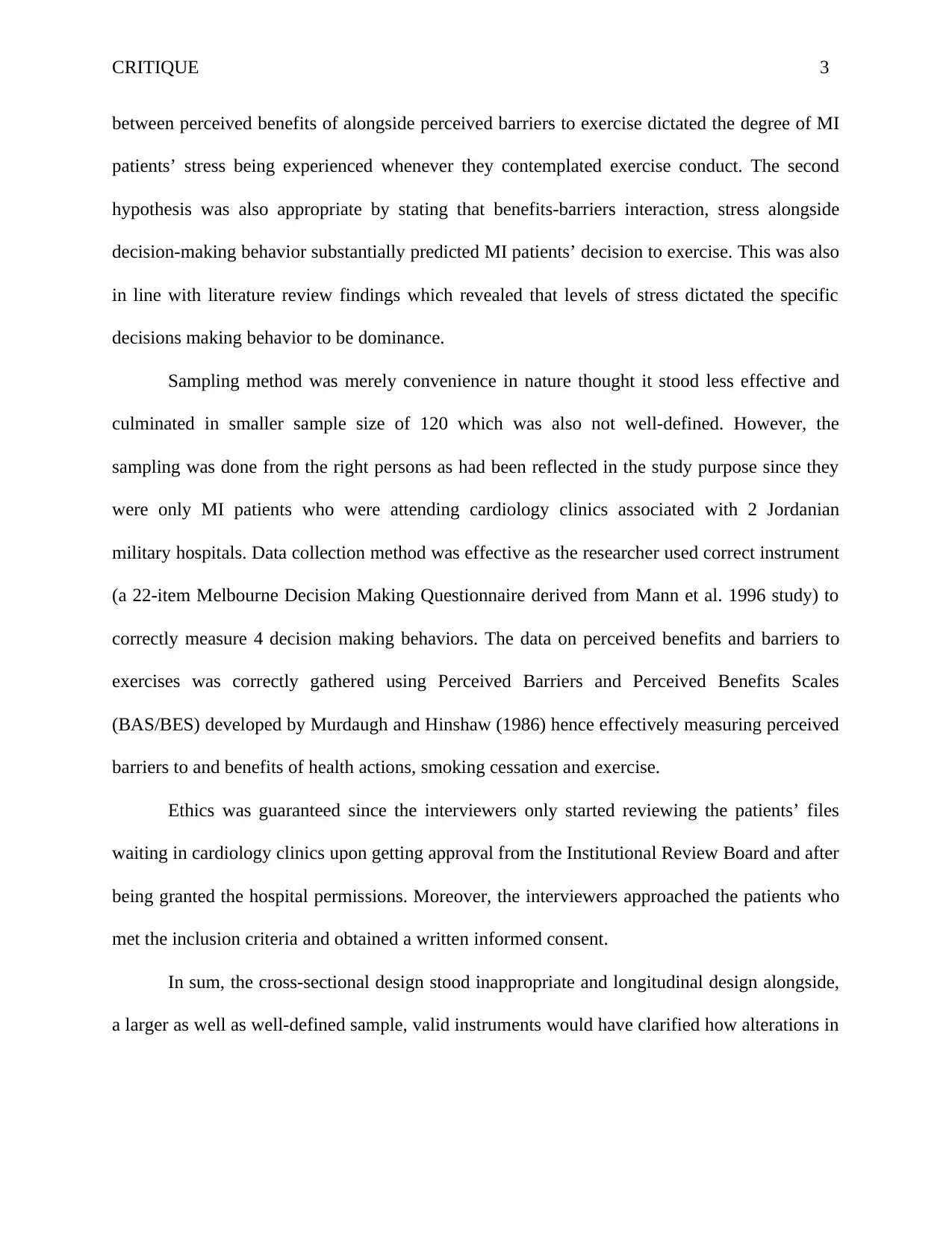
CRITIQUE 3
between perceived benefits of alongside perceived barriers to exercise dictated the degree of MI
patients’ stress being experienced whenever they contemplated exercise conduct. The second
hypothesis was also appropriate by stating that benefits-barriers interaction, stress alongside
decision-making behavior substantially predicted MI patients’ decision to exercise. This was also
in line with literature review findings which revealed that levels of stress dictated the specific
decisions making behavior to be dominance.
Sampling method was merely convenience in nature thought it stood less effective and
culminated in smaller sample size of 120 which was also not well-defined. However, the
sampling was done from the right persons as had been reflected in the study purpose since they
were only MI patients who were attending cardiology clinics associated with 2 Jordanian
military hospitals. Data collection method was effective as the researcher used correct instrument
(a 22-item Melbourne Decision Making Questionnaire derived from Mann et al. 1996 study) to
correctly measure 4 decision making behaviors. The data on perceived benefits and barriers to
exercises was correctly gathered using Perceived Barriers and Perceived Benefits Scales
(BAS/BES) developed by Murdaugh and Hinshaw (1986) hence effectively measuring perceived
barriers to and benefits of health actions, smoking cessation and exercise.
Ethics was guaranteed since the interviewers only started reviewing the patients’ files
waiting in cardiology clinics upon getting approval from the Institutional Review Board and after
being granted the hospital permissions. Moreover, the interviewers approached the patients who
met the inclusion criteria and obtained a written informed consent.
In sum, the cross-sectional design stood inappropriate and longitudinal design alongside,
a larger as well as well-defined sample, valid instruments would have clarified how alterations in
between perceived benefits of alongside perceived barriers to exercise dictated the degree of MI
patients’ stress being experienced whenever they contemplated exercise conduct. The second
hypothesis was also appropriate by stating that benefits-barriers interaction, stress alongside
decision-making behavior substantially predicted MI patients’ decision to exercise. This was also
in line with literature review findings which revealed that levels of stress dictated the specific
decisions making behavior to be dominance.
Sampling method was merely convenience in nature thought it stood less effective and
culminated in smaller sample size of 120 which was also not well-defined. However, the
sampling was done from the right persons as had been reflected in the study purpose since they
were only MI patients who were attending cardiology clinics associated with 2 Jordanian
military hospitals. Data collection method was effective as the researcher used correct instrument
(a 22-item Melbourne Decision Making Questionnaire derived from Mann et al. 1996 study) to
correctly measure 4 decision making behaviors. The data on perceived benefits and barriers to
exercises was correctly gathered using Perceived Barriers and Perceived Benefits Scales
(BAS/BES) developed by Murdaugh and Hinshaw (1986) hence effectively measuring perceived
barriers to and benefits of health actions, smoking cessation and exercise.
Ethics was guaranteed since the interviewers only started reviewing the patients’ files
waiting in cardiology clinics upon getting approval from the Institutional Review Board and after
being granted the hospital permissions. Moreover, the interviewers approached the patients who
met the inclusion criteria and obtained a written informed consent.
In sum, the cross-sectional design stood inappropriate and longitudinal design alongside,
a larger as well as well-defined sample, valid instruments would have clarified how alterations in
⊘ This is a preview!⊘
Do you want full access?
Subscribe today to unlock all pages.

Trusted by 1+ million students worldwide
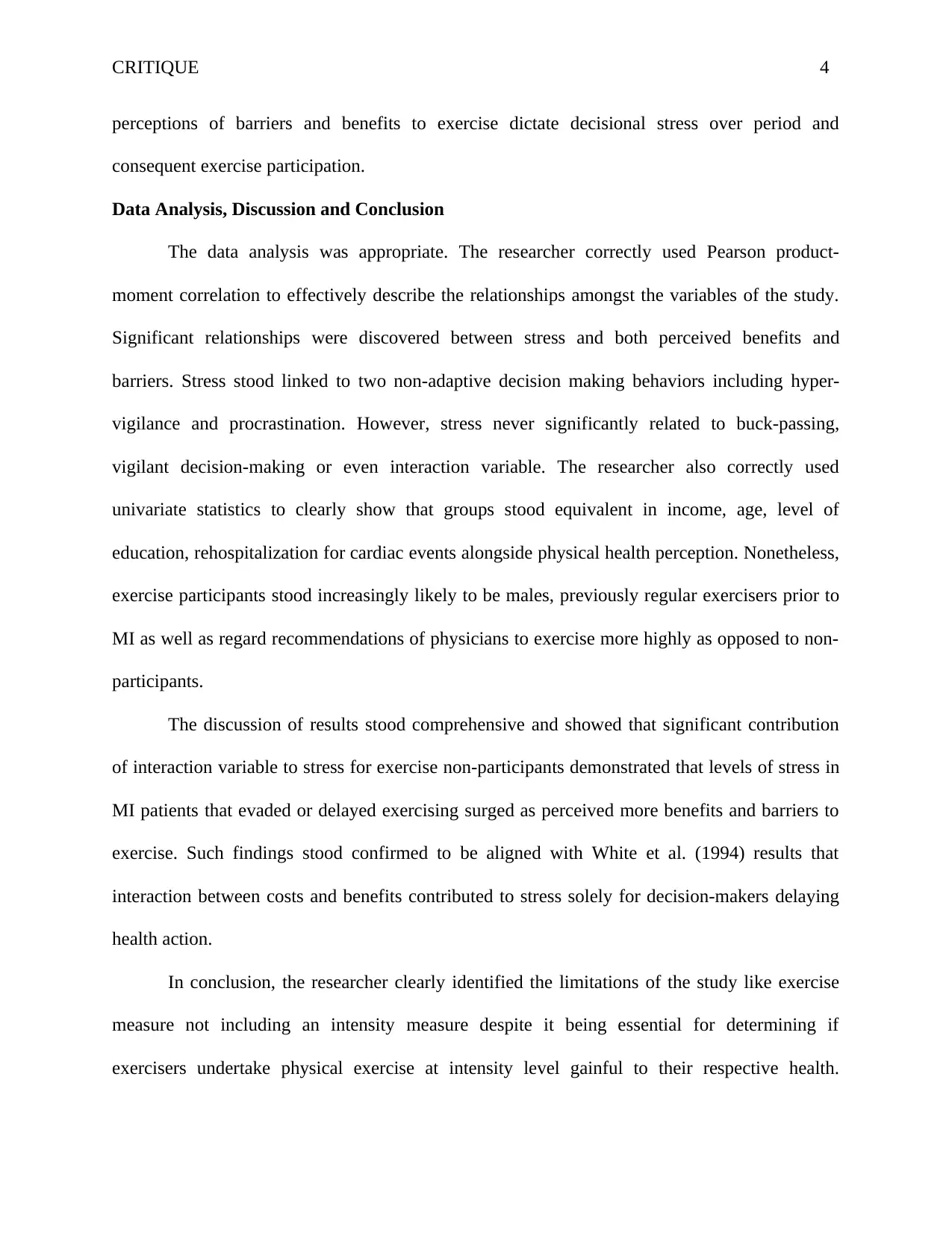
CRITIQUE 4
perceptions of barriers and benefits to exercise dictate decisional stress over period and
consequent exercise participation.
Data Analysis, Discussion and Conclusion
The data analysis was appropriate. The researcher correctly used Pearson product-
moment correlation to effectively describe the relationships amongst the variables of the study.
Significant relationships were discovered between stress and both perceived benefits and
barriers. Stress stood linked to two non-adaptive decision making behaviors including hyper-
vigilance and procrastination. However, stress never significantly related to buck-passing,
vigilant decision-making or even interaction variable. The researcher also correctly used
univariate statistics to clearly show that groups stood equivalent in income, age, level of
education, rehospitalization for cardiac events alongside physical health perception. Nonetheless,
exercise participants stood increasingly likely to be males, previously regular exercisers prior to
MI as well as regard recommendations of physicians to exercise more highly as opposed to non-
participants.
The discussion of results stood comprehensive and showed that significant contribution
of interaction variable to stress for exercise non-participants demonstrated that levels of stress in
MI patients that evaded or delayed exercising surged as perceived more benefits and barriers to
exercise. Such findings stood confirmed to be aligned with White et al. (1994) results that
interaction between costs and benefits contributed to stress solely for decision-makers delaying
health action.
In conclusion, the researcher clearly identified the limitations of the study like exercise
measure not including an intensity measure despite it being essential for determining if
exercisers undertake physical exercise at intensity level gainful to their respective health.
perceptions of barriers and benefits to exercise dictate decisional stress over period and
consequent exercise participation.
Data Analysis, Discussion and Conclusion
The data analysis was appropriate. The researcher correctly used Pearson product-
moment correlation to effectively describe the relationships amongst the variables of the study.
Significant relationships were discovered between stress and both perceived benefits and
barriers. Stress stood linked to two non-adaptive decision making behaviors including hyper-
vigilance and procrastination. However, stress never significantly related to buck-passing,
vigilant decision-making or even interaction variable. The researcher also correctly used
univariate statistics to clearly show that groups stood equivalent in income, age, level of
education, rehospitalization for cardiac events alongside physical health perception. Nonetheless,
exercise participants stood increasingly likely to be males, previously regular exercisers prior to
MI as well as regard recommendations of physicians to exercise more highly as opposed to non-
participants.
The discussion of results stood comprehensive and showed that significant contribution
of interaction variable to stress for exercise non-participants demonstrated that levels of stress in
MI patients that evaded or delayed exercising surged as perceived more benefits and barriers to
exercise. Such findings stood confirmed to be aligned with White et al. (1994) results that
interaction between costs and benefits contributed to stress solely for decision-makers delaying
health action.
In conclusion, the researcher clearly identified the limitations of the study like exercise
measure not including an intensity measure despite it being essential for determining if
exercisers undertake physical exercise at intensity level gainful to their respective health.
Paraphrase This Document
Need a fresh take? Get an instant paraphrase of this document with our AI Paraphraser
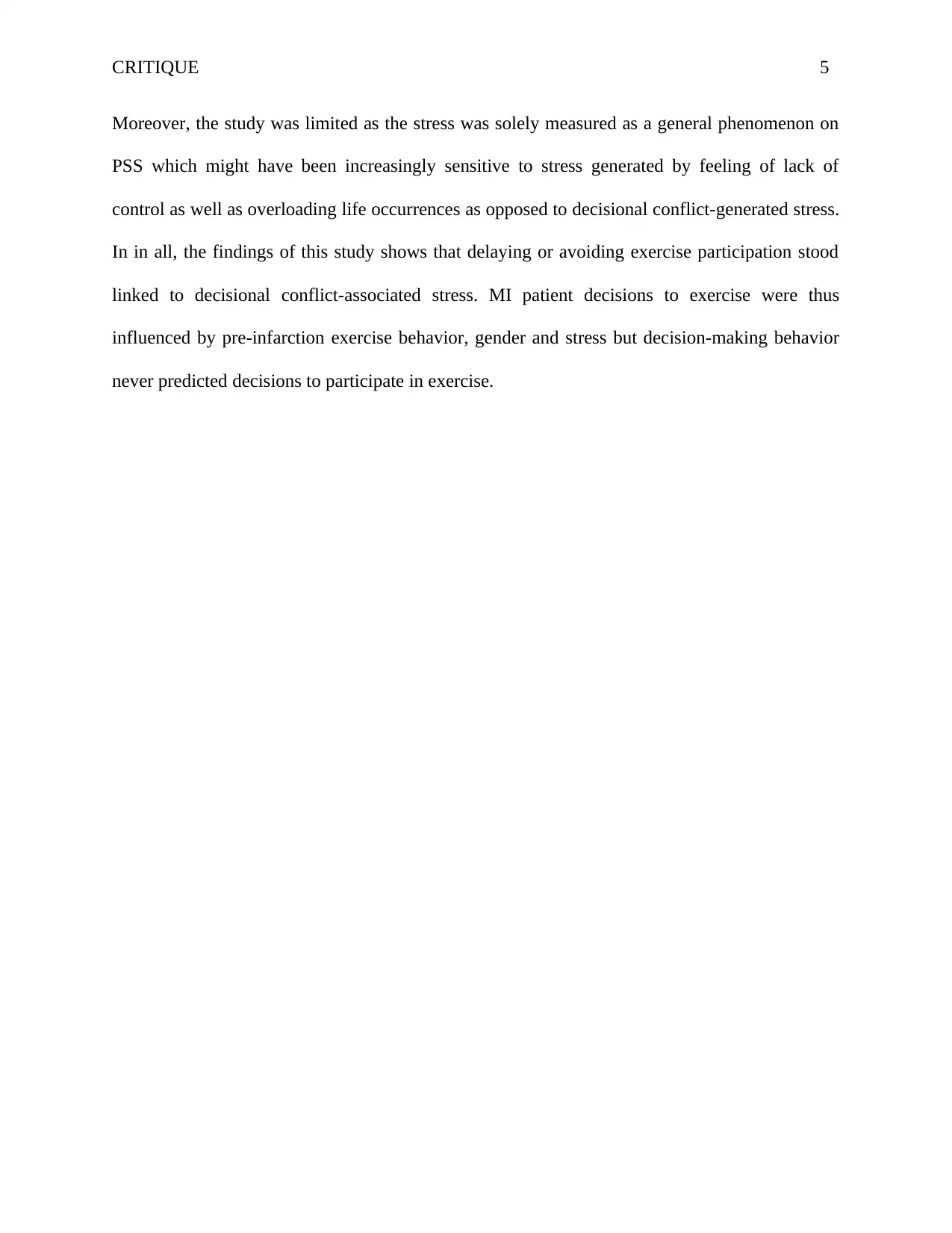
CRITIQUE 5
Moreover, the study was limited as the stress was solely measured as a general phenomenon on
PSS which might have been increasingly sensitive to stress generated by feeling of lack of
control as well as overloading life occurrences as opposed to decisional conflict-generated stress.
In in all, the findings of this study shows that delaying or avoiding exercise participation stood
linked to decisional conflict-associated stress. MI patient decisions to exercise were thus
influenced by pre-infarction exercise behavior, gender and stress but decision-making behavior
never predicted decisions to participate in exercise.
Moreover, the study was limited as the stress was solely measured as a general phenomenon on
PSS which might have been increasingly sensitive to stress generated by feeling of lack of
control as well as overloading life occurrences as opposed to decisional conflict-generated stress.
In in all, the findings of this study shows that delaying or avoiding exercise participation stood
linked to decisional conflict-associated stress. MI patient decisions to exercise were thus
influenced by pre-infarction exercise behavior, gender and stress but decision-making behavior
never predicted decisions to participate in exercise.
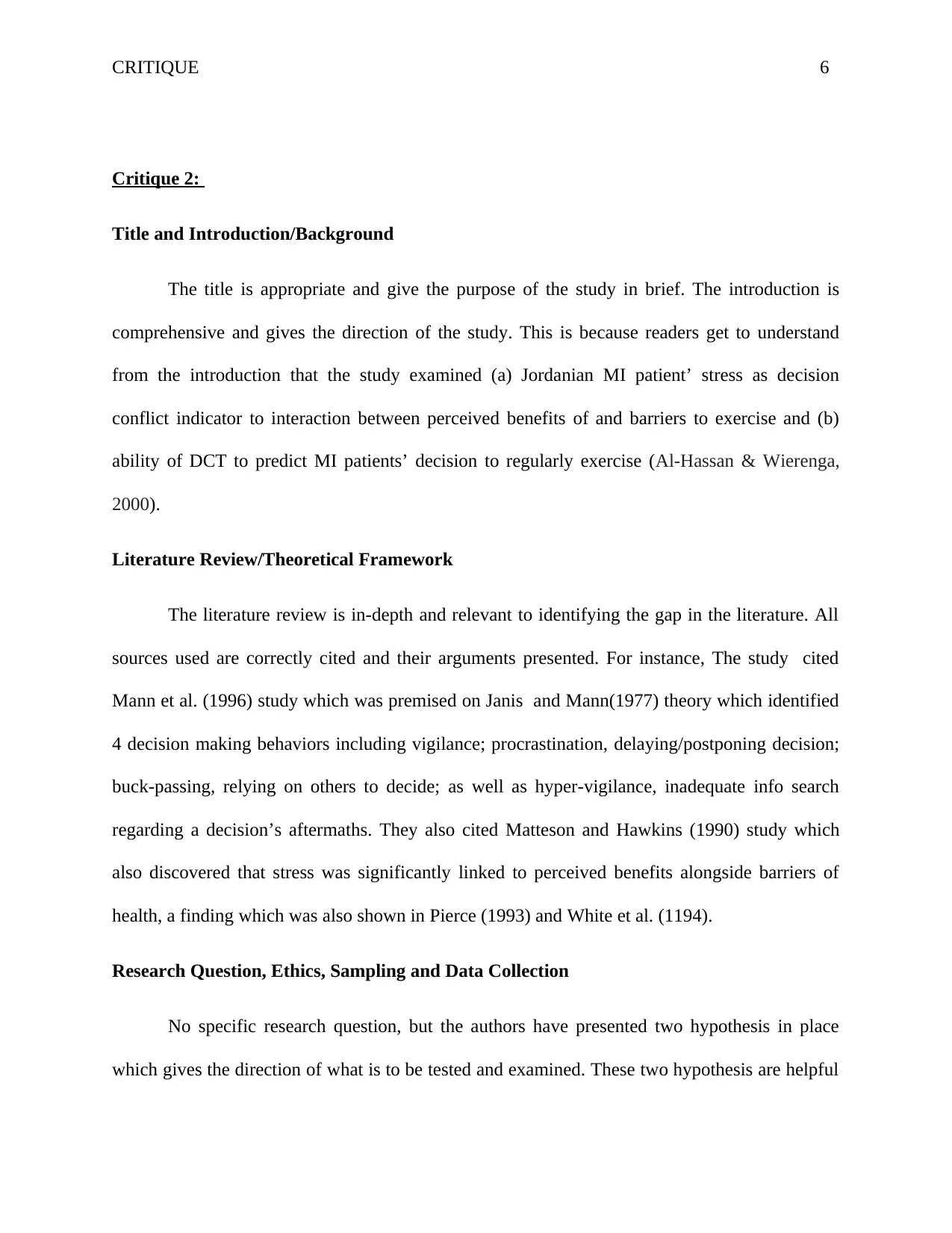
CRITIQUE 6
Critique 2:
Title and Introduction/Background
The title is appropriate and give the purpose of the study in brief. The introduction is
comprehensive and gives the direction of the study. This is because readers get to understand
from the introduction that the study examined (a) Jordanian MI patient’ stress as decision
conflict indicator to interaction between perceived benefits of and barriers to exercise and (b)
ability of DCT to predict MI patients’ decision to regularly exercise (Al-Hassan & Wierenga,
2000).
Literature Review/Theoretical Framework
The literature review is in-depth and relevant to identifying the gap in the literature. All
sources used are correctly cited and their arguments presented. For instance, The study cited
Mann et al. (1996) study which was premised on Janis and Mann(1977) theory which identified
4 decision making behaviors including vigilance; procrastination, delaying/postponing decision;
buck-passing, relying on others to decide; as well as hyper-vigilance, inadequate info search
regarding a decision’s aftermaths. They also cited Matteson and Hawkins (1990) study which
also discovered that stress was significantly linked to perceived benefits alongside barriers of
health, a finding which was also shown in Pierce (1993) and White et al. (1194).
Research Question, Ethics, Sampling and Data Collection
No specific research question, but the authors have presented two hypothesis in place
which gives the direction of what is to be tested and examined. These two hypothesis are helpful
Critique 2:
Title and Introduction/Background
The title is appropriate and give the purpose of the study in brief. The introduction is
comprehensive and gives the direction of the study. This is because readers get to understand
from the introduction that the study examined (a) Jordanian MI patient’ stress as decision
conflict indicator to interaction between perceived benefits of and barriers to exercise and (b)
ability of DCT to predict MI patients’ decision to regularly exercise (Al-Hassan & Wierenga,
2000).
Literature Review/Theoretical Framework
The literature review is in-depth and relevant to identifying the gap in the literature. All
sources used are correctly cited and their arguments presented. For instance, The study cited
Mann et al. (1996) study which was premised on Janis and Mann(1977) theory which identified
4 decision making behaviors including vigilance; procrastination, delaying/postponing decision;
buck-passing, relying on others to decide; as well as hyper-vigilance, inadequate info search
regarding a decision’s aftermaths. They also cited Matteson and Hawkins (1990) study which
also discovered that stress was significantly linked to perceived benefits alongside barriers of
health, a finding which was also shown in Pierce (1993) and White et al. (1194).
Research Question, Ethics, Sampling and Data Collection
No specific research question, but the authors have presented two hypothesis in place
which gives the direction of what is to be tested and examined. These two hypothesis are helpful
⊘ This is a preview!⊘
Do you want full access?
Subscribe today to unlock all pages.

Trusted by 1+ million students worldwide
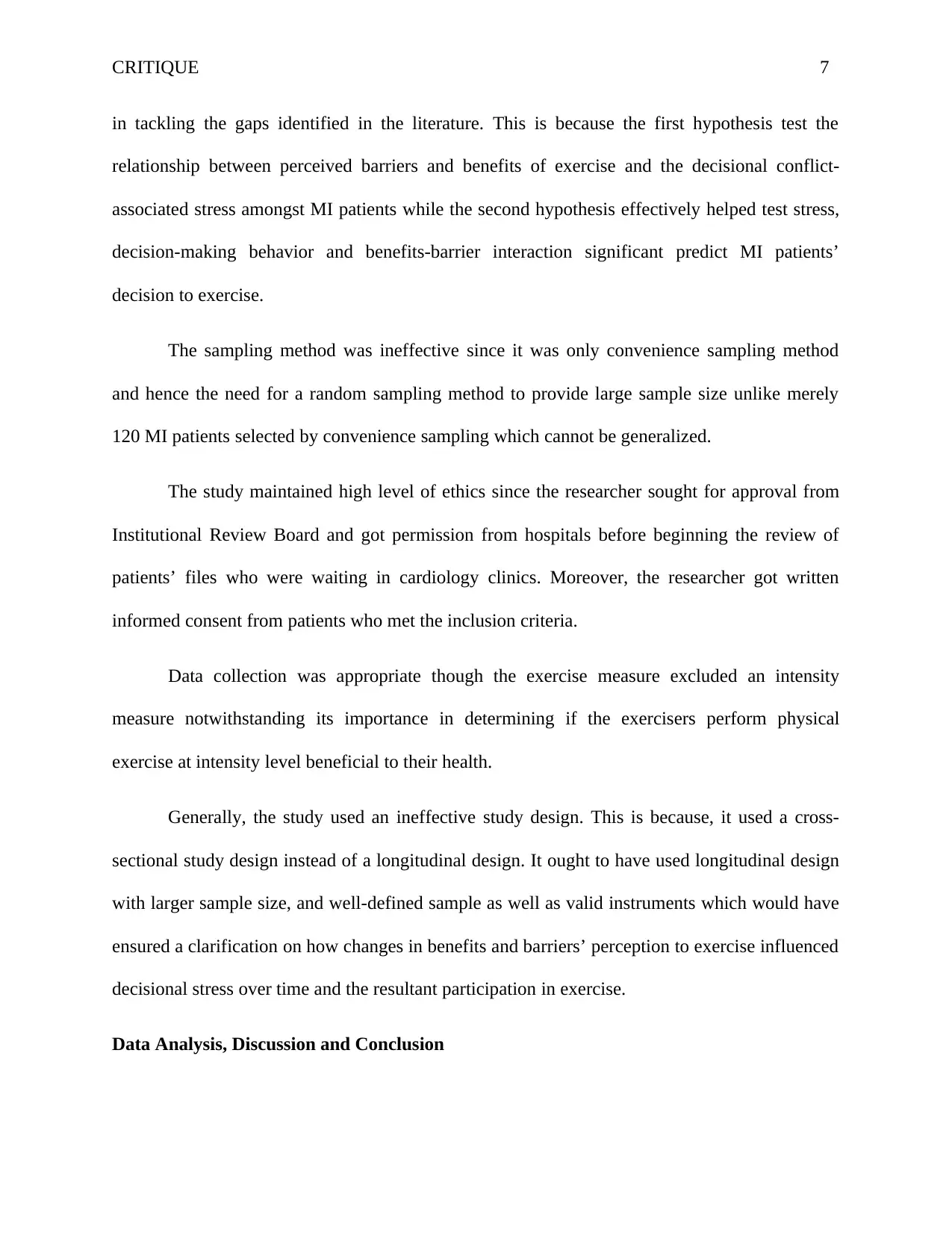
CRITIQUE 7
in tackling the gaps identified in the literature. This is because the first hypothesis test the
relationship between perceived barriers and benefits of exercise and the decisional conflict-
associated stress amongst MI patients while the second hypothesis effectively helped test stress,
decision-making behavior and benefits-barrier interaction significant predict MI patients’
decision to exercise.
The sampling method was ineffective since it was only convenience sampling method
and hence the need for a random sampling method to provide large sample size unlike merely
120 MI patients selected by convenience sampling which cannot be generalized.
The study maintained high level of ethics since the researcher sought for approval from
Institutional Review Board and got permission from hospitals before beginning the review of
patients’ files who were waiting in cardiology clinics. Moreover, the researcher got written
informed consent from patients who met the inclusion criteria.
Data collection was appropriate though the exercise measure excluded an intensity
measure notwithstanding its importance in determining if the exercisers perform physical
exercise at intensity level beneficial to their health.
Generally, the study used an ineffective study design. This is because, it used a cross-
sectional study design instead of a longitudinal design. It ought to have used longitudinal design
with larger sample size, and well-defined sample as well as valid instruments which would have
ensured a clarification on how changes in benefits and barriers’ perception to exercise influenced
decisional stress over time and the resultant participation in exercise.
Data Analysis, Discussion and Conclusion
in tackling the gaps identified in the literature. This is because the first hypothesis test the
relationship between perceived barriers and benefits of exercise and the decisional conflict-
associated stress amongst MI patients while the second hypothesis effectively helped test stress,
decision-making behavior and benefits-barrier interaction significant predict MI patients’
decision to exercise.
The sampling method was ineffective since it was only convenience sampling method
and hence the need for a random sampling method to provide large sample size unlike merely
120 MI patients selected by convenience sampling which cannot be generalized.
The study maintained high level of ethics since the researcher sought for approval from
Institutional Review Board and got permission from hospitals before beginning the review of
patients’ files who were waiting in cardiology clinics. Moreover, the researcher got written
informed consent from patients who met the inclusion criteria.
Data collection was appropriate though the exercise measure excluded an intensity
measure notwithstanding its importance in determining if the exercisers perform physical
exercise at intensity level beneficial to their health.
Generally, the study used an ineffective study design. This is because, it used a cross-
sectional study design instead of a longitudinal design. It ought to have used longitudinal design
with larger sample size, and well-defined sample as well as valid instruments which would have
ensured a clarification on how changes in benefits and barriers’ perception to exercise influenced
decisional stress over time and the resultant participation in exercise.
Data Analysis, Discussion and Conclusion
Paraphrase This Document
Need a fresh take? Get an instant paraphrase of this document with our AI Paraphraser
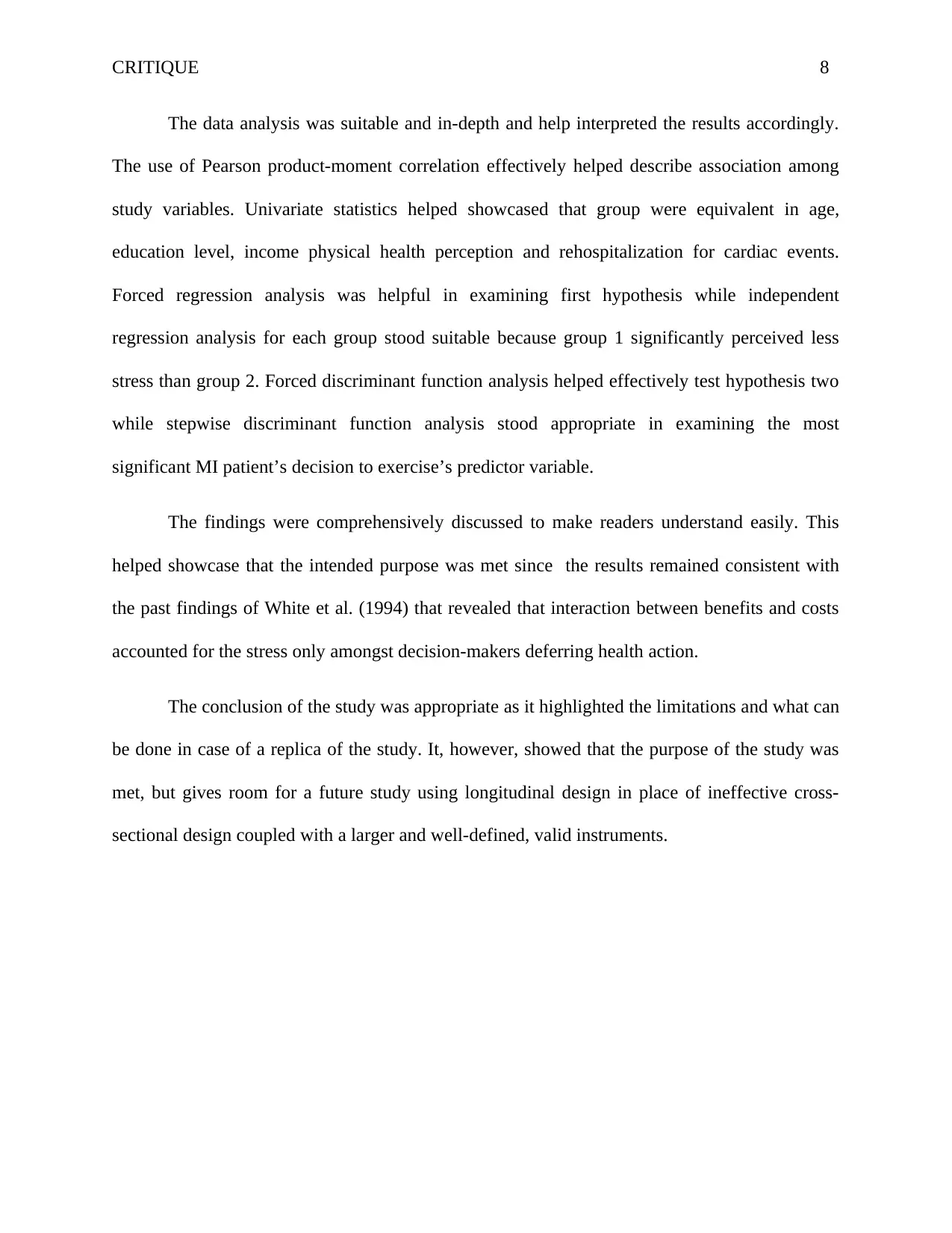
CRITIQUE 8
The data analysis was suitable and in-depth and help interpreted the results accordingly.
The use of Pearson product-moment correlation effectively helped describe association among
study variables. Univariate statistics helped showcased that group were equivalent in age,
education level, income physical health perception and rehospitalization for cardiac events.
Forced regression analysis was helpful in examining first hypothesis while independent
regression analysis for each group stood suitable because group 1 significantly perceived less
stress than group 2. Forced discriminant function analysis helped effectively test hypothesis two
while stepwise discriminant function analysis stood appropriate in examining the most
significant MI patient’s decision to exercise’s predictor variable.
The findings were comprehensively discussed to make readers understand easily. This
helped showcase that the intended purpose was met since the results remained consistent with
the past findings of White et al. (1994) that revealed that interaction between benefits and costs
accounted for the stress only amongst decision-makers deferring health action.
The conclusion of the study was appropriate as it highlighted the limitations and what can
be done in case of a replica of the study. It, however, showed that the purpose of the study was
met, but gives room for a future study using longitudinal design in place of ineffective cross-
sectional design coupled with a larger and well-defined, valid instruments.
The data analysis was suitable and in-depth and help interpreted the results accordingly.
The use of Pearson product-moment correlation effectively helped describe association among
study variables. Univariate statistics helped showcased that group were equivalent in age,
education level, income physical health perception and rehospitalization for cardiac events.
Forced regression analysis was helpful in examining first hypothesis while independent
regression analysis for each group stood suitable because group 1 significantly perceived less
stress than group 2. Forced discriminant function analysis helped effectively test hypothesis two
while stepwise discriminant function analysis stood appropriate in examining the most
significant MI patient’s decision to exercise’s predictor variable.
The findings were comprehensively discussed to make readers understand easily. This
helped showcase that the intended purpose was met since the results remained consistent with
the past findings of White et al. (1994) that revealed that interaction between benefits and costs
accounted for the stress only amongst decision-makers deferring health action.
The conclusion of the study was appropriate as it highlighted the limitations and what can
be done in case of a replica of the study. It, however, showed that the purpose of the study was
met, but gives room for a future study using longitudinal design in place of ineffective cross-
sectional design coupled with a larger and well-defined, valid instruments.
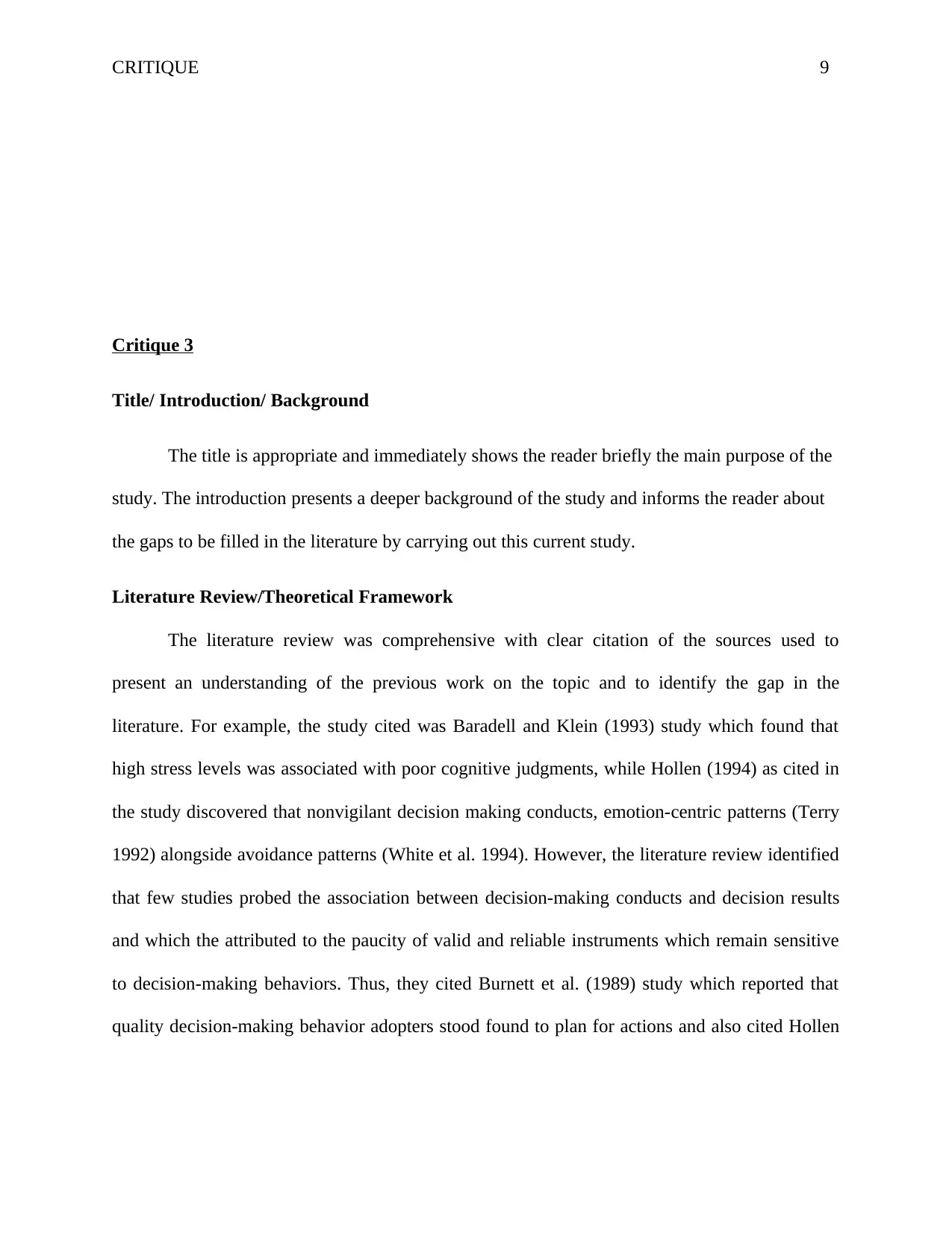
CRITIQUE 9
Critique 3
Title/ Introduction/ Background
The title is appropriate and immediately shows the reader briefly the main purpose of the
study. The introduction presents a deeper background of the study and informs the reader about
the gaps to be filled in the literature by carrying out this current study.
Literature Review/Theoretical Framework
The literature review was comprehensive with clear citation of the sources used to
present an understanding of the previous work on the topic and to identify the gap in the
literature. For example, the study cited was Baradell and Klein (1993) study which found that
high stress levels was associated with poor cognitive judgments, while Hollen (1994) as cited in
the study discovered that nonvigilant decision making conducts, emotion-centric patterns (Terry
1992) alongside avoidance patterns (White et al. 1994). However, the literature review identified
that few studies probed the association between decision-making conducts and decision results
and which the attributed to the paucity of valid and reliable instruments which remain sensitive
to decision-making behaviors. Thus, they cited Burnett et al. (1989) study which reported that
quality decision-making behavior adopters stood found to plan for actions and also cited Hollen
Critique 3
Title/ Introduction/ Background
The title is appropriate and immediately shows the reader briefly the main purpose of the
study. The introduction presents a deeper background of the study and informs the reader about
the gaps to be filled in the literature by carrying out this current study.
Literature Review/Theoretical Framework
The literature review was comprehensive with clear citation of the sources used to
present an understanding of the previous work on the topic and to identify the gap in the
literature. For example, the study cited was Baradell and Klein (1993) study which found that
high stress levels was associated with poor cognitive judgments, while Hollen (1994) as cited in
the study discovered that nonvigilant decision making conducts, emotion-centric patterns (Terry
1992) alongside avoidance patterns (White et al. 1994). However, the literature review identified
that few studies probed the association between decision-making conducts and decision results
and which the attributed to the paucity of valid and reliable instruments which remain sensitive
to decision-making behaviors. Thus, they cited Burnett et al. (1989) study which reported that
quality decision-making behavior adopters stood found to plan for actions and also cited Hollen
⊘ This is a preview!⊘
Do you want full access?
Subscribe today to unlock all pages.

Trusted by 1+ million students worldwide
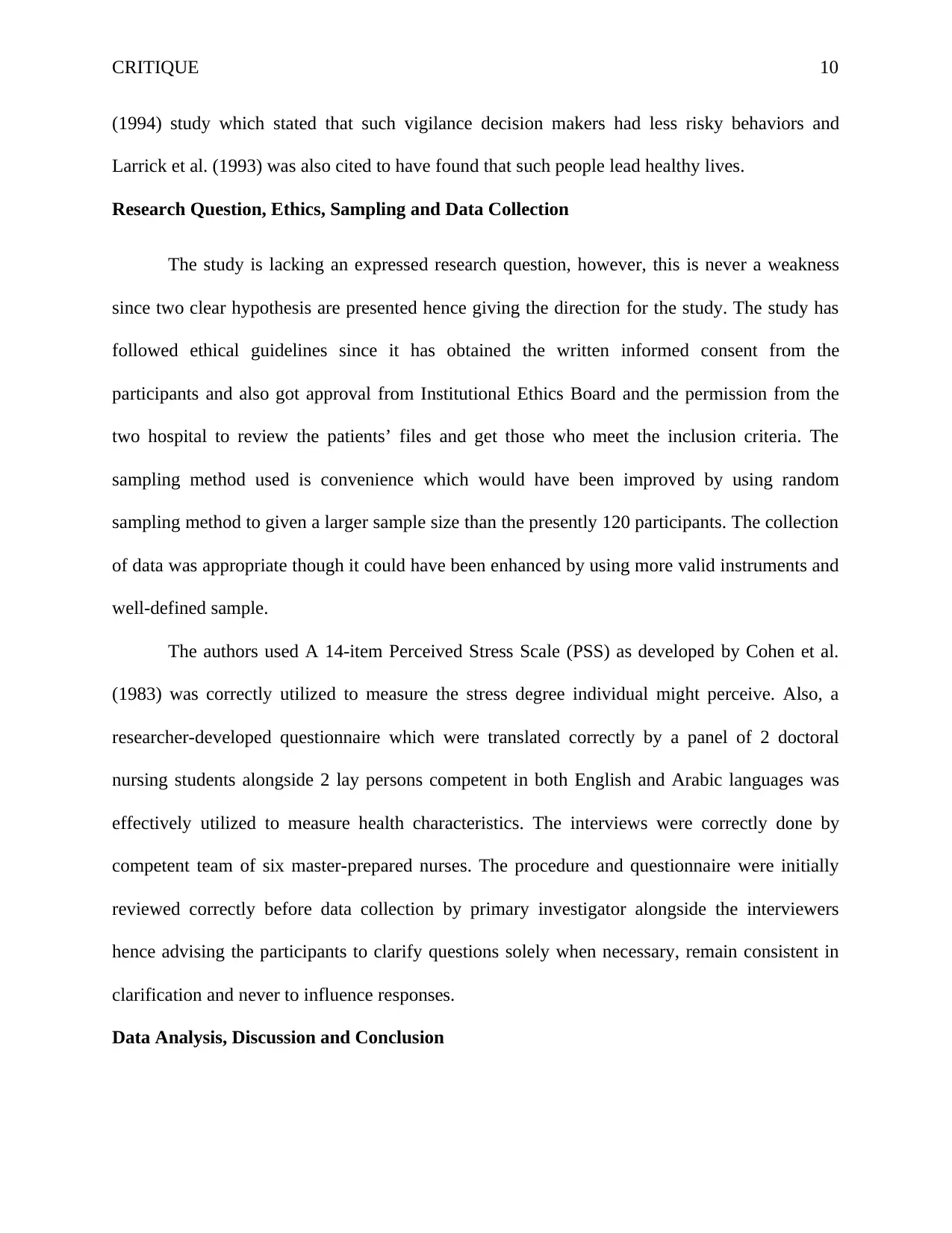
CRITIQUE 10
(1994) study which stated that such vigilance decision makers had less risky behaviors and
Larrick et al. (1993) was also cited to have found that such people lead healthy lives.
Research Question, Ethics, Sampling and Data Collection
The study is lacking an expressed research question, however, this is never a weakness
since two clear hypothesis are presented hence giving the direction for the study. The study has
followed ethical guidelines since it has obtained the written informed consent from the
participants and also got approval from Institutional Ethics Board and the permission from the
two hospital to review the patients’ files and get those who meet the inclusion criteria. The
sampling method used is convenience which would have been improved by using random
sampling method to given a larger sample size than the presently 120 participants. The collection
of data was appropriate though it could have been enhanced by using more valid instruments and
well-defined sample.
The authors used A 14-item Perceived Stress Scale (PSS) as developed by Cohen et al.
(1983) was correctly utilized to measure the stress degree individual might perceive. Also, a
researcher-developed questionnaire which were translated correctly by a panel of 2 doctoral
nursing students alongside 2 lay persons competent in both English and Arabic languages was
effectively utilized to measure health characteristics. The interviews were correctly done by
competent team of six master-prepared nurses. The procedure and questionnaire were initially
reviewed correctly before data collection by primary investigator alongside the interviewers
hence advising the participants to clarify questions solely when necessary, remain consistent in
clarification and never to influence responses.
Data Analysis, Discussion and Conclusion
(1994) study which stated that such vigilance decision makers had less risky behaviors and
Larrick et al. (1993) was also cited to have found that such people lead healthy lives.
Research Question, Ethics, Sampling and Data Collection
The study is lacking an expressed research question, however, this is never a weakness
since two clear hypothesis are presented hence giving the direction for the study. The study has
followed ethical guidelines since it has obtained the written informed consent from the
participants and also got approval from Institutional Ethics Board and the permission from the
two hospital to review the patients’ files and get those who meet the inclusion criteria. The
sampling method used is convenience which would have been improved by using random
sampling method to given a larger sample size than the presently 120 participants. The collection
of data was appropriate though it could have been enhanced by using more valid instruments and
well-defined sample.
The authors used A 14-item Perceived Stress Scale (PSS) as developed by Cohen et al.
(1983) was correctly utilized to measure the stress degree individual might perceive. Also, a
researcher-developed questionnaire which were translated correctly by a panel of 2 doctoral
nursing students alongside 2 lay persons competent in both English and Arabic languages was
effectively utilized to measure health characteristics. The interviews were correctly done by
competent team of six master-prepared nurses. The procedure and questionnaire were initially
reviewed correctly before data collection by primary investigator alongside the interviewers
hence advising the participants to clarify questions solely when necessary, remain consistent in
clarification and never to influence responses.
Data Analysis, Discussion and Conclusion
Paraphrase This Document
Need a fresh take? Get an instant paraphrase of this document with our AI Paraphraser
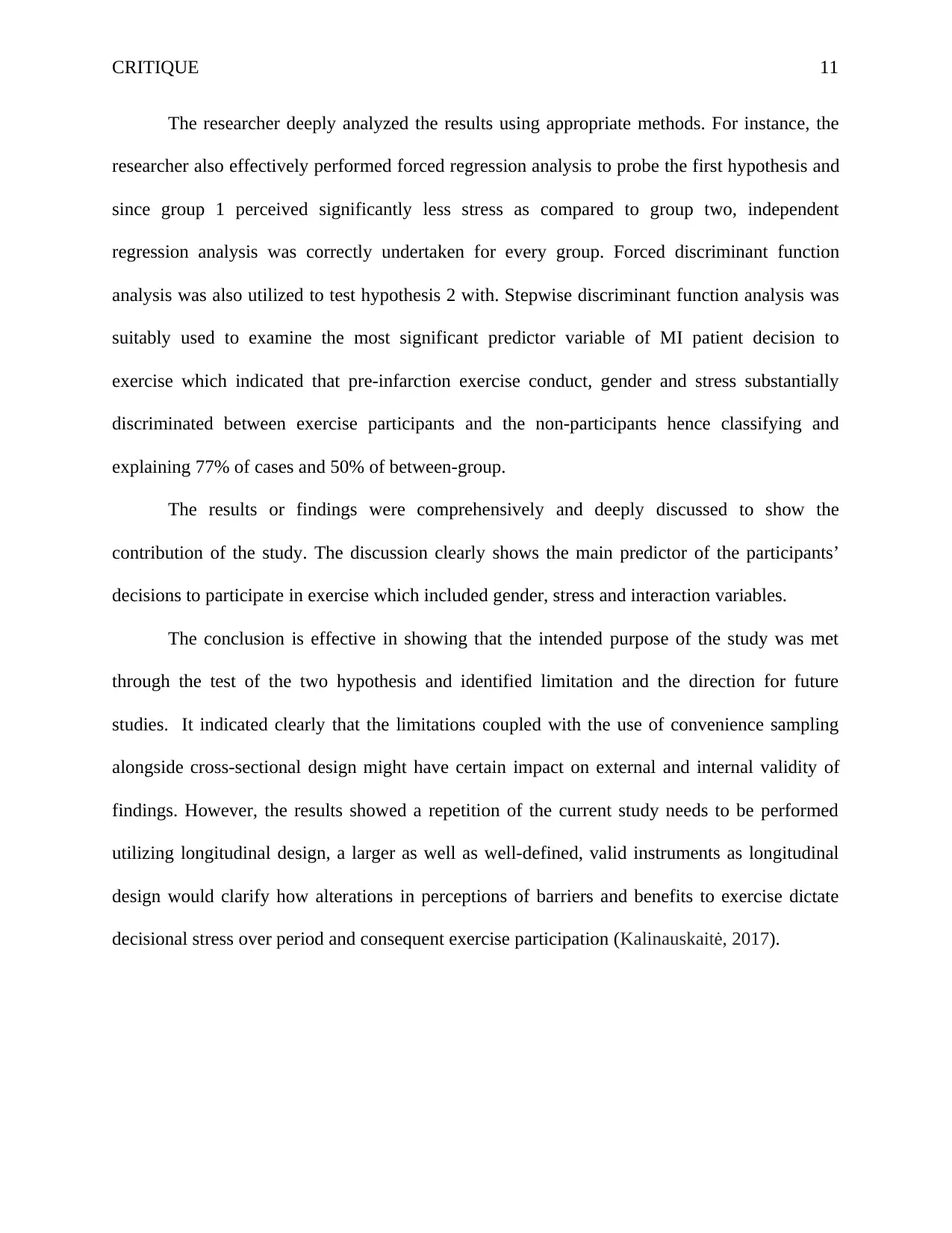
CRITIQUE 11
The researcher deeply analyzed the results using appropriate methods. For instance, the
researcher also effectively performed forced regression analysis to probe the first hypothesis and
since group 1 perceived significantly less stress as compared to group two, independent
regression analysis was correctly undertaken for every group. Forced discriminant function
analysis was also utilized to test hypothesis 2 with. Stepwise discriminant function analysis was
suitably used to examine the most significant predictor variable of MI patient decision to
exercise which indicated that pre-infarction exercise conduct, gender and stress substantially
discriminated between exercise participants and the non-participants hence classifying and
explaining 77% of cases and 50% of between-group.
The results or findings were comprehensively and deeply discussed to show the
contribution of the study. The discussion clearly shows the main predictor of the participants’
decisions to participate in exercise which included gender, stress and interaction variables.
The conclusion is effective in showing that the intended purpose of the study was met
through the test of the two hypothesis and identified limitation and the direction for future
studies. It indicated clearly that the limitations coupled with the use of convenience sampling
alongside cross-sectional design might have certain impact on external and internal validity of
findings. However, the results showed a repetition of the current study needs to be performed
utilizing longitudinal design, a larger as well as well-defined, valid instruments as longitudinal
design would clarify how alterations in perceptions of barriers and benefits to exercise dictate
decisional stress over period and consequent exercise participation (Kalinauskaitė, 2017).
The researcher deeply analyzed the results using appropriate methods. For instance, the
researcher also effectively performed forced regression analysis to probe the first hypothesis and
since group 1 perceived significantly less stress as compared to group two, independent
regression analysis was correctly undertaken for every group. Forced discriminant function
analysis was also utilized to test hypothesis 2 with. Stepwise discriminant function analysis was
suitably used to examine the most significant predictor variable of MI patient decision to
exercise which indicated that pre-infarction exercise conduct, gender and stress substantially
discriminated between exercise participants and the non-participants hence classifying and
explaining 77% of cases and 50% of between-group.
The results or findings were comprehensively and deeply discussed to show the
contribution of the study. The discussion clearly shows the main predictor of the participants’
decisions to participate in exercise which included gender, stress and interaction variables.
The conclusion is effective in showing that the intended purpose of the study was met
through the test of the two hypothesis and identified limitation and the direction for future
studies. It indicated clearly that the limitations coupled with the use of convenience sampling
alongside cross-sectional design might have certain impact on external and internal validity of
findings. However, the results showed a repetition of the current study needs to be performed
utilizing longitudinal design, a larger as well as well-defined, valid instruments as longitudinal
design would clarify how alterations in perceptions of barriers and benefits to exercise dictate
decisional stress over period and consequent exercise participation (Kalinauskaitė, 2017).
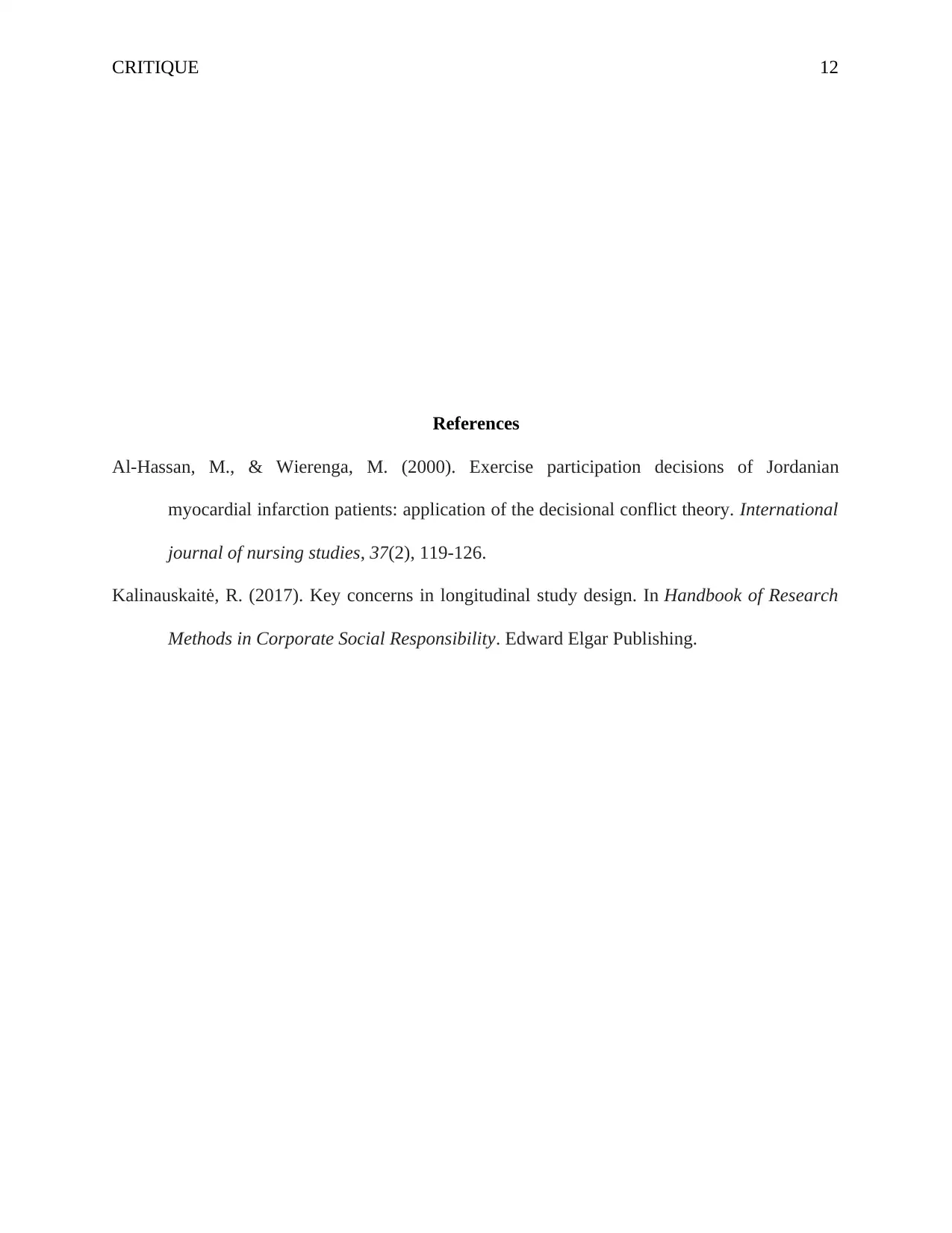
CRITIQUE 12
References
Al-Hassan, M., & Wierenga, M. (2000). Exercise participation decisions of Jordanian
myocardial infarction patients: application of the decisional conflict theory. International
journal of nursing studies, 37(2), 119-126.
Kalinauskaitė, R. (2017). Key concerns in longitudinal study design. In Handbook of Research
Methods in Corporate Social Responsibility. Edward Elgar Publishing.
References
Al-Hassan, M., & Wierenga, M. (2000). Exercise participation decisions of Jordanian
myocardial infarction patients: application of the decisional conflict theory. International
journal of nursing studies, 37(2), 119-126.
Kalinauskaitė, R. (2017). Key concerns in longitudinal study design. In Handbook of Research
Methods in Corporate Social Responsibility. Edward Elgar Publishing.
⊘ This is a preview!⊘
Do you want full access?
Subscribe today to unlock all pages.

Trusted by 1+ million students worldwide
1 out of 12
Your All-in-One AI-Powered Toolkit for Academic Success.
+13062052269
info@desklib.com
Available 24*7 on WhatsApp / Email
![[object Object]](/_next/static/media/star-bottom.7253800d.svg)
Unlock your academic potential
Copyright © 2020–2025 A2Z Services. All Rights Reserved. Developed and managed by ZUCOL.


